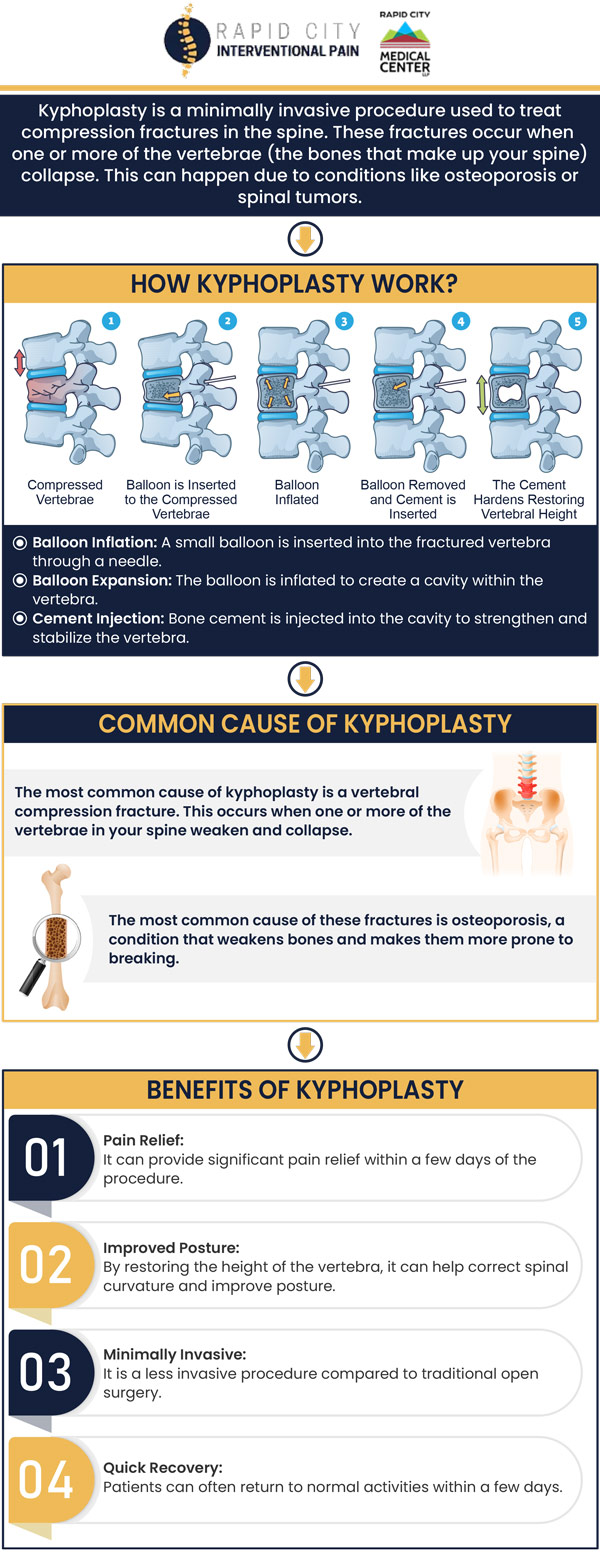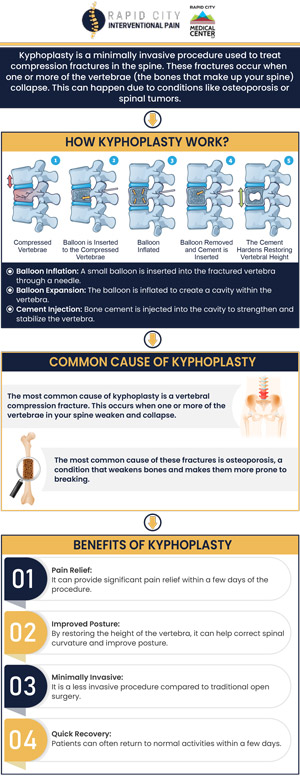Kyphoplasty for Compression Fractures in Rapid City, SD
Doctors utilize kyphoplasty to treat compression fractures, which are microscopic splits in the spine’s bones caused by an injury. The most noticeable symptom of a spinal compression fracture is back discomfort. It may begin slowly and worsen over time or appear abruptly and quickly. Dr. Lance Doeden and Dr. Tyler Ptacek offer kyphoplasty for compression fractures, which is available at Rapid City Interventional Pain Management Clinic. For more information, contact us or book an appointment online. We are conveniently located at 101 E Minnesota St. Suite 301 Rapid City, SD 57701.




Table of Contents:
How serious are compression fractures?
Does kyphoplasty cure a compression fracture?
How long does it take a compression fracture to heal after kyphoplasty?
What happens if you don’t treat a compression fracture?
Compression fractures are a type of injury that affects the vertebrae of the spine, ranging in severity and type but having a variety of treatment options available to ensure that the spine can heal properly and that any pain experienced due to the injury is minimal.
Compression fractures can vary quite a bit in severity depending on the location, extent, and type of fracture that is incurred. Some fractures can end up being pretty mild, causing some discomfort but being able to heal from home with sufficient rest and time, whereas serious compression fractures will require more intensive medical interventions, possibly requiring surgery to ensure that the fracture heals properly. The most severe type of compression fractures includes burst fractures, during which the affected vertebrae are crushed and fragmented, causing substantial pain and spinal instability in patients. With burst fractures, there is also a risk of surrounding internal structures incurring damage, leading to further complications. Any type of compression fracture should be addressed as quickly as possible by a qualified healthcare provider to ensure that any required treatments or precautions can be taken to ensure that the injury can heal properly.
Kyphoplasty is a minimally invasive procedure that is frequently used to treat several different types of compression fractures, particularly those that are the result of osteoporosis. In cases where the compression fracture was caused by osteoporosis, kyphoplasty is not able to cure the underlying condition but is a very effective option to provide significant pain relief and restore vertebral height as well as spinal alignment. The procedure involves the insertion of a small balloon into the fractured vertebra which is then inflated to create a small space into which bone cement can be injected. This bone cement will stabilize the fracture, resulting in significant pain relief. While kyphoplasty is a great treatment option for many patients suffering from a compression fracture, it may not be the best solution in every case, so it is best to consult with a qualified healthcare provider to determine if this course of treatment is the most appropriate method of treatment for your specific situation.
The amount of time it takes for a compression fracture to fully heal following kyphoplasty is predominantly dependent on the fracture’s severity and how quickly the individual naturally heals. In general, patients can expect their compression fracture that has been treated in this manner to heal within several weeks to a few months. To ensure that your compression fracture heals properly and within the expected timeline, it is essential to follow all provided instructions and recommendations regarding restrictions on physical activity, and proper pain management, and to ensure that proper follow-up treatment is sought. While providing you with all necessary aftercare instructions, the healthcare professional who performed the kyphoplasty will be able to provide you with a more accurate estimate regarding the timeline for healing that is based on the extent of your compression fracture as well as your current health status.
If you don’t receive proper treatment for a compression fracture, there is a chance that the injury could result in various complications and further unnecessary pain. There are some cases where the compression fracture is very minor, only requiring sufficient rest and caution to heal properly, but even then, the injury should be assessed by a medical professional to ensure that no further interventions or stabilization of the spine are recommended.
More severe cases being left untreated can result in the inability of the compression fracture to heal properly, leading to chronic pain, limited mobility, and an increased risk of fractures occurring again in the future. There is also a chance that permanent spinal deformities could result if the compression fracture is left untreated and heals improperly, such as an excessive curvature of the spine, which can lead to further impact on your quality of life. Regardless of the severity of the compression fracture, the injury should be taken seriously, with medical attention being sought to ensure an accurate diagnosis with appropriate treatment. For more information, contact us or book an appointment online. We are conveniently located at 101 E Minnesota St. Suite 301 Rapid City, SD 57701. We serve patients from Rapid City SD, Rapid Valley SD, Black Hawk SD, Box Elder SD, Sturgis SD, and surrounding areas.

Additional Services You May Need
▸ Back Pain Treatment
▸ Neck Pain Treatment
▸ Joint Pain Treatment
▸ Nerve Pain Treatment
▸ Degenerative Disc Disease
▸ Arthritis Pain Treatment
▸ Diabetic Neuropathy Treatment
▸ Headaches Treatment
▸ Shoulder Pain Treatment
▸ Hip Pain Treatment
▸ Spinal Cord Stimulator
▸ Complex regional pain
▸ Knee Pain Treatment
▸ Sciatica Pain Treatment

Additional Services You May Need
▸ Back Pain Treatment
▸ Neck Pain Treatment
▸ Joint Pain Treatment
▸ Nerve Pain Treatment
▸ Degenerative Disc Disease
▸ Arthritis Pain Treatment
▸ Diabetic Neuropathy Treatment
▸ Headaches Treatment
▸ Shoulder Pain Treatment
▸ Hip Pain Treatment
▸ Spinal Cord Stimulator
▸ Complex regional pain
▸ Knee Pain Treatment
▸ Sciatica Pain Treatment



